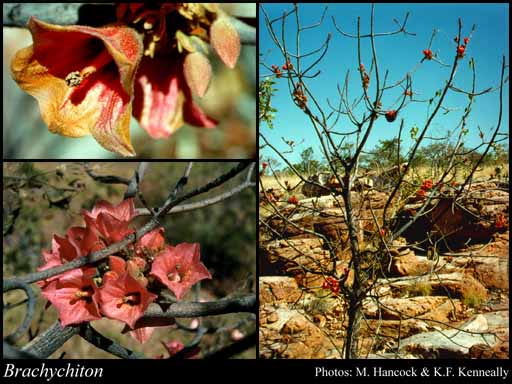- Reference
- Melet.Bot. 34 (1832)
- Name Status
- Current

Scientific Description
Family Sterculiaceae.
(Subfamily Sterculioideae), Tribe Sterculieae.
Habit and leaf form. Trees (mostly), or shrubs; dry-season deciduous, or evergreen. To 1–45 m high. Mesophytic. Leaves medium-sized; alternate; petiolate; simple. Leaf blades dorsiventral (sometimes discolourous); dissected (3–7(-9)-lobed), or entire. Mature leaf blades adaxially glabrous, or pubescent, or woolly; abaxially glabrous, or pubescent, or woolly. Leaves with stipules. Stipules caducous, or persistent. Leaf anatomy. Hairs present, or absent; glandular hairs present, or absent. Unicellular hairs present, or absent. Complex hairs present, or absent. Complex hairs stellate.
Reproductive type, pollination. Fertile flowers functionally male, or functionally female. Unisexual flowers present (functionally unisexual by abortion). Plants monoecious, or dioecious. Female flowers with staminodes (10–30, petaloid, connate, arranged in 5 bundles, raised on the androgynophore).
Inflorescence and flower features. Flowers aggregated in ‘inflorescences’. Inflorescence few-flowered to many-flowered. Flowers in panicles, or in heads (or metabotryoids or metaxytriads, rarely metaxymonads). Inflorescences axillary, or cauliflorous (or ramal). Flowers pedicellate (pedicels articulate); bracteate. Bracts deciduous, or persistent (rarely). Flowers regular. Floral receptacle developing an androphore, or developing a gynophore (ie. an androgynophore). Hypogynous disk present, or absent. Perianth with distinct calyx and corolla (petaloid calyces); 3–5. Calyx present; (4–)5(–8); 1 -whorled; gamosepalous; lobed; lobulate ((4-)5(-8)-lobed); hairy; valvate (or compressed-campanulate); tubular; brown, or white, or red, or pink, or orange (or orange-red, different colours adaxially and abaxially). Epicalyx absent. Corolla absent. Androecium present. Fertile stamens present (in male flowers only), or absent (in female flowers only). Androecium 10–30. Androecial members stamens raised on the androgynophore; coherent (connate: filaments connate laterally forming a short tube); 5 - adelphous (5 antetepalous stamens innermost and 2–5 stamens occupying each alternitepalous bend of the sinuate line), or 1 - adelphous. Androecium exclusively of fertile stamens. Anthers basifixed; dehiscing via longitudinal slits; extrorse; bilocular; tetrasporangiate. Fertile gynoecium present (in female flowers; rudimentary in male flowers). Gynoecium 5 carpelled (raised on the androgynophore, rudimentary in male flowers). The pistil 5 celled. Gynoecium syncarpous; synstylovarious to eu-syncarpous; superior. Ovary unilocular; 1 locular. Ovary summit hairy, the hairs not confined to radiating bands. Gynoecium stylate. Styles 5; partially joined (free at base, connate above); hairy. Stigmas 5 (basally or fully connate); peltate. Placentation laminar-dispersed. Ovules in the single cavity 2–140; anatropous.
Fruit and seed features. Fruit 15–200 mm long; stipitate, or subsessile; dark brown to black, or yellow; hairy (woolly), or not hairy; a schizocarp. Mericarps 5; comprising follicles (cymbiform, beaked, dehiscing longitudinally along the inner suture). Dispersal unit the seed (surrounded by exotesta giving the appearance of honey-like compartments). Seeds 2 or more per mericarp (2–140). Seeds endospermic (copious). Endosperm oily. Seeds not compressed (ovoid or ovoid-oblong or ellipsoid, sometimes angular); small to medium sized; conspicuously hairy. Cotyledons flat. Embryo straight. Testa smooth (or rugose).
Geography, cytology, number of species. World distribution: Australia and Papua New Guinea. Native of Australia. Not endemic to Australia. Australian states and territories: Western Australia, South Australia, Northern Territory, Queensland, New South Wales, Victoria, and Australian Capital Territory. Northern Botanical Province and Eremaean Botanical Province. A genus of 31 species; 11 species in Western Australia; 7 endemic to Western Australia.
Additional comments. Name derived from the Greek brachys (short) and chiton (tunic or covering).